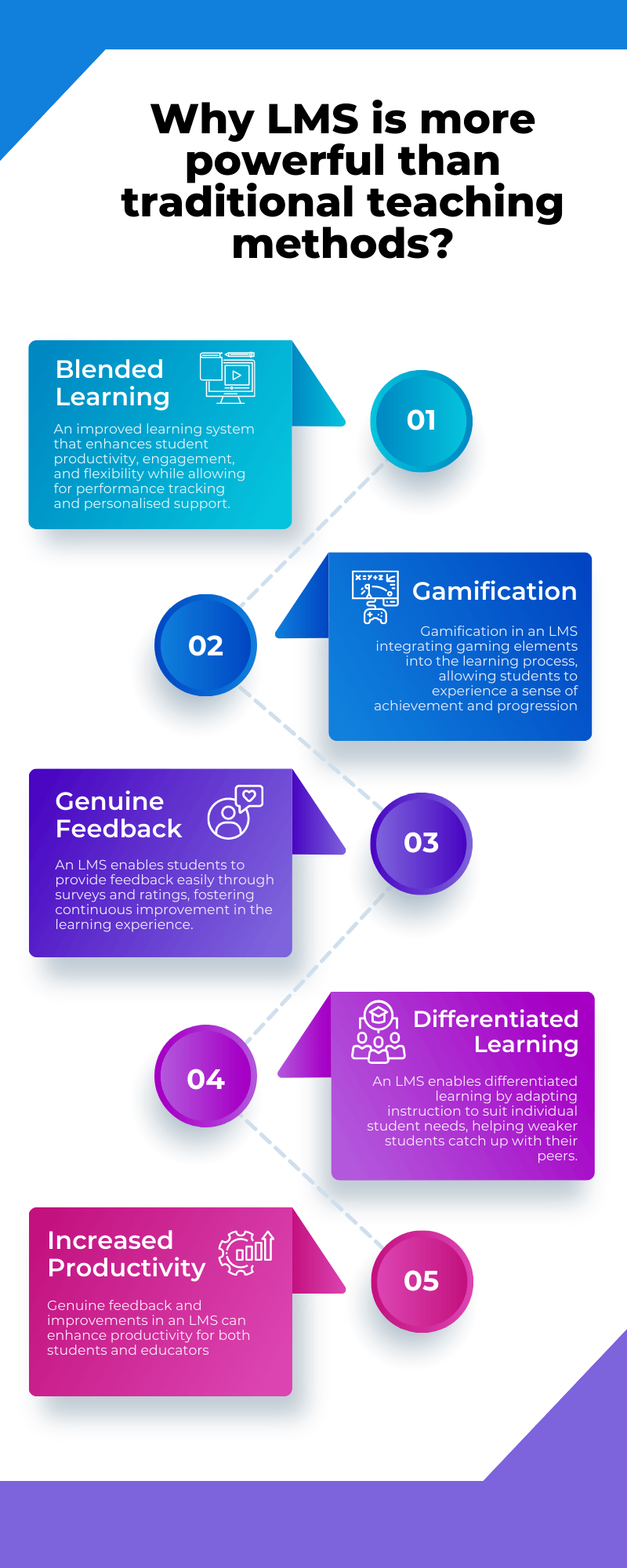How An LMS Can Help Improve Education Delivery
As the demand for modern and personalized education grows, it has become difficult to keep track of students' performance and improve their learning abilities with the traditional methods of teaching. It has become far more difficult for educators to be on the same page as their students. In spite of regular efforts of upgrading teaching ways, it is impossible to keep an eye on every student and give special attention to those who need it.
The limitations of traditional teaching methods in meeting these evolving expectations have lessened the importance of finding innovative solutions that bridge the gap between traditional and modern approaches to education. Nowadays, parents and students both are increasingly seeking an educational environment that offers enhanced learning opportunities, progress tracking, and interactive engagement. In this context, school LMSs have emerged as platforms that enable educational institutions to transform their teaching methodologies and adapt to the needs of today's learners.
What Is An LMS For Educational Institutions?
A school LMS is a software used by educational institutions to enhance, manage, and plan the learning process for students. It facilitates online learning and enables trackable progress. An LMS for education offers various features specifically designed for education, including:
- Course creation
Admins can easily create courses by making content, timelines, and assigning tasks. - Online assessments
Educators can create multiple online tests and assessments without the burden of manually grading them. An LMS for education automates the evaluation process and assigns grades to students accordingly. - Dashboard
LMSs provide both educators and students with personalized dashboards. Students can track and analyze their academic growth, as well as review their performance in specific tests through their dashboards. Educators can assess their students' progress by accessing the dashboard. - Virtual classrooms
Learning management systems for schools enable teachers to organize online classrooms and share course materials with students. This allows students to access the course content at their convenience while maintaining a collaborative learning environment.
How Can A School LMS Help?
Nowadays, parents and students both prefer modern methods of teaching and seek educational environments where children can thrive. They value learning environments that provide opportunities to track progress, measure performance, and engage in healthy competition with peers. A crucial tool that enables these capabilities is a Learning Management System (LMS).
The importance of an LMS in the education LMS system has been established. Now, let's explore how an institution can utilize an LMS to enhance productivity and overall reputation. The following are the key benefits of LMSs:
1. Blended Learning
Blended learning involves combining online education with traditional classrooms. This approach improves the overall learning system and offers additional benefits. It enhances student productivity, making the learning experience more engaging compared to traditional methods. It also allows students to study online, providing flexibility and convenience.
2. Gamification
Gamification involves incorporating gaming elements into the learning process. By introducing gamification features in an LMS, students experience a sense of achievement and progression, similar to winning a game or advancing levels. For instance, students can level up upon passing tests or receive higher grades when completing chapters.
3. Genuine Feedback From Learners
Through an LMS, students can easily provide feedback by filling out surveys and rating courses. This open feedback system benefits students and educators, allowing for continuous improvement in the overall learning experience.
4. Differentiated Learning
In a traditional classroom, catering to the diverse learning paces and abilities of individual students can be challenging. However, an LMS facilitates differentiated learning, enabling educators to present information in a way that suits each student's needs. By estimating the pace of learning for each student, teachers can deliver instruction more effectively and help weaker students catch up with their peers.
5. Increasing Productivity
Adopting a new teaching method and becoming familiar with the associated software and functionality can be challenging. To ensure the successful integration of an LMS, it is crucial to select a user-friendly platform. An LMS for education should be accessible to students of all age groups and easy for educators to navigate. Workshops can be conducted to educate students, parents, and teachers about the features of the LMS, its benefits, and how it can help them achieve their goals.
It is important to consider these points to maximize the potential of the LMS and create a productive educational environment for both educators and learners.
What Are The Benefits Of Using An LMS In Schools?
Once we learn about the education LMS a simple question arises in our mind: What is the importance of an LMS in education when traditional methods can be used to educate students? To answer this question we first need to understand how learning with an LMS is different from the traditional methods of learning.
1. Course Availability
In traditional teaching, not every student has access to all the course material in one place and neither students nor educators can individually define a learning path for each student. An LMS gives you the flexibility on how to store your content over it, and with the help of an LMS, a student can have access to the whole curriculum all the one place and an educator can define a learning path for each student individually.
2. Discussion Forums
An LMS gives an educator and a student an opportunity to have an open discussion. Over a discussion forum, a student can ask questions over chat, while the educator and other students can answer. These discussion forums are accessible to all, and you can revisit them anytime you want to re-reference the same question.
3. Reporting To Parents
An LMS gives the teacher flexibility to check a student's profile and, with the help of analytics, they can judge how the student is performing and the ways in which their performance can be improved. Educators can define a different learning path for each student and can give timely reports to their parents about their performance, which is near to impossible in the traditional ways of teaching. A parent also has access to the student’s profile and they can visit and check their student’s performance at any time.
4. Performance Analytics
It is difficult for an educator to track the performance of each and every student but, with the help of an LMS, even the low-performing students can be given the opportunity to improve their performance.

With the help of proper analysis, course curriculum, and timely reports a student’s performance can be improved exponentially, which doesn’t always happen when we use traditional ways of teaching.
What Are The Different Types Of LMSs For Education?
There are four commonly used types of LMSs, and it is important to carefully consider the purpose and specific needs before selecting an LMS. Factors such as budget, setup time, and user-friendliness for the team should also be taken into account.
While LMSs were traditionally associated with the education sector, they are now widely used in a variety of enterprises to train their employees. These LMS are commonly termed enterprise and corporate LMSs, each with different use cases and benefits. When it comes to educational institutions, the selection of an LMS should be approached with careful consideration.
1. SaaS LMS (Cloud-Based)
Users can simply plug and run the SaaS LMS and upload content to make it ready for learners. Many educational institutions opt for SaaS LMSs due to their ease of use and management.
Limitation
Some SaaS LMS options may need to be further customized or personalized for specific learners.
2. Installed LMS
For institutions prioritizing security, an installed LMS is an ideal choice. Data can be hosted on the institution's own server. Users can utilize their existing server or build a custom LMS tailored to their institution's needs.
Limitation
As the institution grows, the cost of maintaining server upgrades and uploads may increase.
3. Open-Source LMS
Open-source LMS software is freely available for everyone to use. This option is suitable for institutions that want to create a custom LMS without starting from scratch.
Limitation
Installing upgrades can be challenging and time-consuming.
4. Custom-Built LMS
A custom-built LMS is designed for educational institutions with substantial budgets and a clear vision of how they want their LMS to look and function. It can be developed by an in-house team or outsourced to a development team.
Limitation
Creating a custom-built LMS involves significant time, cost, and resource investment.
Understanding the different types of LMSs available makes it easier to identify the most suitable option for an institution's needs.
What Criteria Should You Use To Choose An LMS For Education?
When selecting an LMS for an institution, there are several important factors to consider. Here is a list of key considerations:
- User Interface
The LMS should have an interactive and user-friendly interface for students. If the LMS is not easy to navigate and use, it may disrupt the education LMS and discourage learners from utilizing it effectively. - Usability and compatibility
The LMS should be easily usable and have straightforward setup procedures. Providing video LMS tutorials can assist students in setting up the LMS comfortably. Additionally, the LMS should be compatible with various devices, allowing users to access it from anywhere. - Student performance tracking
An effective LMS should be capable of efficiently tracking students' performance and providing detailed analytics. Having comprehensive information about students' progress allows educators to customize the course to better meet individual needs. - Price and setup
The LMS should offer easy setup, management, and maintenance processes to ensure smooth communication for all users. When considering purchasing an LMS, it is essential to carefully evaluate the pricing plans and check for any hidden costs not directly listed by the vendor. - Video security
Video security is important for institutions to protect their course content. It is crucial to assess if the chosen LMS provides video security measures without imposing excessive financial burdens.
Considering these factors from a third-person perspective can help institutions make informed decisions when selecting an LMS that best suits their needs.
What Are The Key Features To Consider When Looking For An Education LMS?
When selecting a school LMS, it can be challenging to determine the right features to prioritize. However, there are several ways to assess which features will be most beneficial:
- User management
The ability to add and manage users, assign roles, and create learner groups provides flexibility for students to participate in the learning community. - Course management
This feature enables educators to create tailored courses for students, aligning them with individual learning progress and growth. - Progress tracking
Real-time progress tracking allows educators to monitor student performance and provide timely feedback. - Gamification
Implementing gamification features, such as tasks with points, awards, ratings, and badges, can enhance learner retention, engagement, and motivation. - Video classroom
Creating live video classrooms allows students to join and learn together, simulating the offline classroom experience. However, institutions must also prioritize video LMS security to prevent content piracy.
Considering these features can help institutions make informed decisions and choose an LMS that aligns with their specific requirements.
Conclusion
In this article, the role of Learning Management Systems (LMSs) in transforming education is discussed, emphasizing their ability to enhance learning experiences and outcomes. The benefits of implementing an LMS in schools are outlined, including convenient access to course materials, opportunities for collaborative learning through discussion forums, effective reporting to parents, and the availability of performance analytics for tracking individual progress.
When selecting an LMS, institutions are advised to consider factors such as User Interface, usability, compatibility, student performance tracking, pricing, and video security. Additionally, the article suggests that features like user management, course management, progress tracking, gamification, and video classrooms can further enhance the educational experience. Overall, the article highlights the significance of LMSs in the education sector and provides insights into the considerations and features that can contribute to effective LMS implementation in educational institutions.







